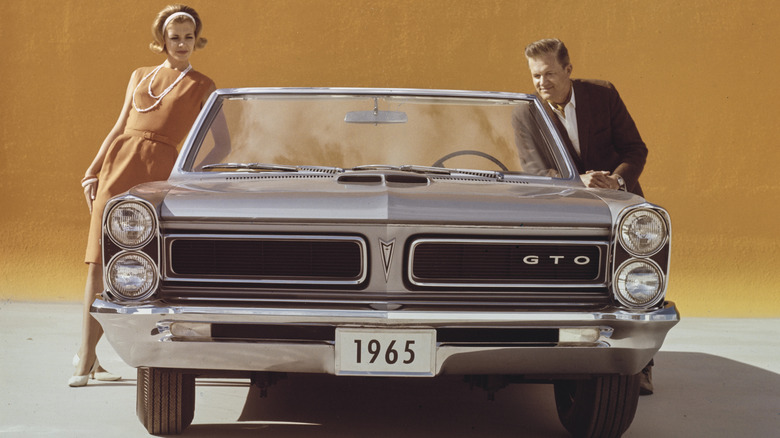Pontiac has long been a brand that has set itself apart through the distinctive design of many of its cars. For much of its history, going back as far as 1932, Pontiacs had shared their bodies with Chevrolets. While this may have been done by then-GM President Alfred Sloan to cut Pontiac’s production costs during the Great Depression, it continued as a way for Pontiac achieve economies of scale within General Motors. It also gave Pontiac a reason to forge its own identity within the GM hierarchy as the next step up from a Chevy.
Advertisement
Over the years, Pontiac would go on to differentiate itself from plain-Jane Chevrolets using a variety of design techniques. Some of these, like the Silver Streak, took the Pontiac’s look upscale with a unique application of chrome trim. Others, like the Wide Track chassis and related developments, brought an aggressive new look that hinted at Pontiac’s performance bona fides lurking underneath.
The Silver Streak set Pontiacs apart from the 1930s through the 1950s
One of Pontiac’s early design innovations was the use of chrome strips that ran from the cowl to the bumper and gave the Silver Streak trim its name. The feature and package first appeared in 1935. It was part of a major redesign under the guidance of design head Frank Hershey, and included an art deco-inspired design with bold, round fenders, a split windshield, a steel top replacing the former fabric roof panels, and rear-hinged suicide doors. The streaks appeared on several models and took various forms over the years, going through changes in width and spacing.
Advertisement
By the mid ’50s, Pontiac’s new General Manager Semon E. “Bunky” Knudsen thought that the Silver Streak look was dated and had run its course. He likened the feature to “an old man’s suspenders.” The last Silver Streak Pontiac rolled off the line in 1956, but that was far from the end of the brand’s design innovations.
The Wide Track look was accompanied by a new split grille
After the Silver Streak had come and gone, it was time to redefine Pontiac for a new generation. In 1959, Pontiac introduced its “Wide Track” chassis, which spread the wheels a full 5 inches further apart in order to increase stability. This move also filled out the wheel wells for a more aggressive look. Once again, Pontiacs had a distinctive design feature.
Advertisement
On some models, the wide-track stance was highlighted by a split front grille, which returned in 1959 after an extended hiatus. This feature, which was at its shortest at the car’s center and broadened as it reached the fenders, highlighted the stance of the wide-track models. This design was a smash hit, and helped boost Pontiac’s sales by a whopping 77% in 1959. The 1960 facelift was already prepared at that point, so the split grille took a one-year break before returning in 1961. It would remain a Pontiac hallmark until the end of the brand’s run. It even appeared on the Aztek, which was the butt of many jokes upon its release but may have just been ahead of its time.
The Firebird’s beak set it apart from the Camaro
Necessity is the mother of invention, and led to yet another Pontiac design feature that defined the brand. In 1967, the spectacular success of the Ford Mustang prompted General Motors to rush their Mustang competitors to market. Chevrolet would have its Camaro and Pontiac got the Firebird, which is named after a legendary Native American symbol which “promised action, power, beauty, and youth.” Among the interesting facts regarding the 1967 Firebird is the tidbit that GM’s relentless cost-cutting forced Pontiac to reuse the Camaro front fenders and doors.
Advertisement
To distinguish Pontiac’s pony car from its Chevy cousin, the design team gave the Firebird a front end with a tapered “bird beak,” plus a hood to match. Other 1967 Firebird styling features that set it apart were a different taillight arrangement from the Camaro’s, well as fake louvers placed just behind the doors. Mission accomplished! The Firebird lived through the 2002 model year, retaining the signature beak with slight tweaks.
The Endura bumper began with the 1968 GTO
As Pontiac advanced through the 1960s and 1970s, performance became an important differentiating factor. While performance was easily defined by engine output and other mechanical specifications, styling was what could really set a car apart from its competitors. Pontiac introduced its 1968 GTO with a unique design feature. This was the first car to use the Endura closed-cell urethane front bumper, which was painted the same color as the car. Pontiac boss John Z. DeLorean appeared in a GTO commercial, whacking the Endura bumper with a sledgehammer and producing no damage.
Advertisement
The Endura bumper could resist heat, oil, gasoline, sunlight, and even salt water. It also returned to its original shape after an impact. Until the Endura appeared, most cars had chrome bumpers that were difficult to blend with a car’s front end design. The Endura also found its way to other GM models in the succeeding years, and the feature presaged the body-colored, impact-resistant bumpers found on almost all modern cars.









